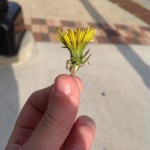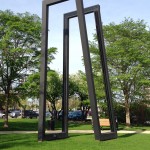In celebration of the spring weather, Skokie Public Library took our latest offering of Be the Scientist outdoors for a community photo walk. Be the Scientist is an hour-long program offered monthly for kids in grades 3-5 and encourages participants to try on different STEAM-related personas. It is part of a monthly series of programming including Be the Chef and Be the Artist. For this month, we asked participants to be photographers as well as civic engineers. Here’s what we did.
The program began with two discussion prompts: What makes a community? What makes a good photograph? We then worked through each question, writing down responses as kids chimed in. For what makes a community, participants were rather insightful and listed things like diverse people, a library, and communication. For what makes a good photograph, participants continued sharing their insight, suggesting ways to hold the camera, finding the right position, and ensuring you have enough light. We then briefly talked about how a digital camera works before transitioning to our cameras: iPad 2s. With the iPads, we shared best practices about using the camera app. Participants were quick to share suggestions on zooming, focusing, and holding the iPad.
Since we were going outside and using iPads, we talked about ways to get better lighting and quality exposure since we didn’t have a flash option. We also shared ground rules about the walk. We had 3 adult staff members going on the community walk, and in light of low attendance, this was a great adult to child ratio. Our walking route was less than a mile and only crossed one major street (which included a crosswalk). As we walked and as the participants took photos, we talked about what they were seeing and asked them to share observations. Specifically, we asked: When walking, think about what you’re looking at and how it adds value to the community or takes value away. Further, think about what the different pieces are for forming a community. While we perhaps had high hopes for discussion around these questions, they didn’t go over very well–geese and bugs and general excitement of being outside were all distracting components of the walk.
Once we returned to the library, we verified we had the correct email addresses for the participants and then got to work creating Google Drive folders of all photos for each photographer. We shared these and our staff photographer posted a selection of the photographers on Flickr. We were really impressed by many of the kids’ photos.
This was a relatively low-cost program since we used the library’s classroom set of iPads. The time it took to share the photographs from each locked down iPad was more than expected, however. If you’re looking to offer this type of program, we suggest having a more efficient plan in place ahead of time.






Leave A Comment